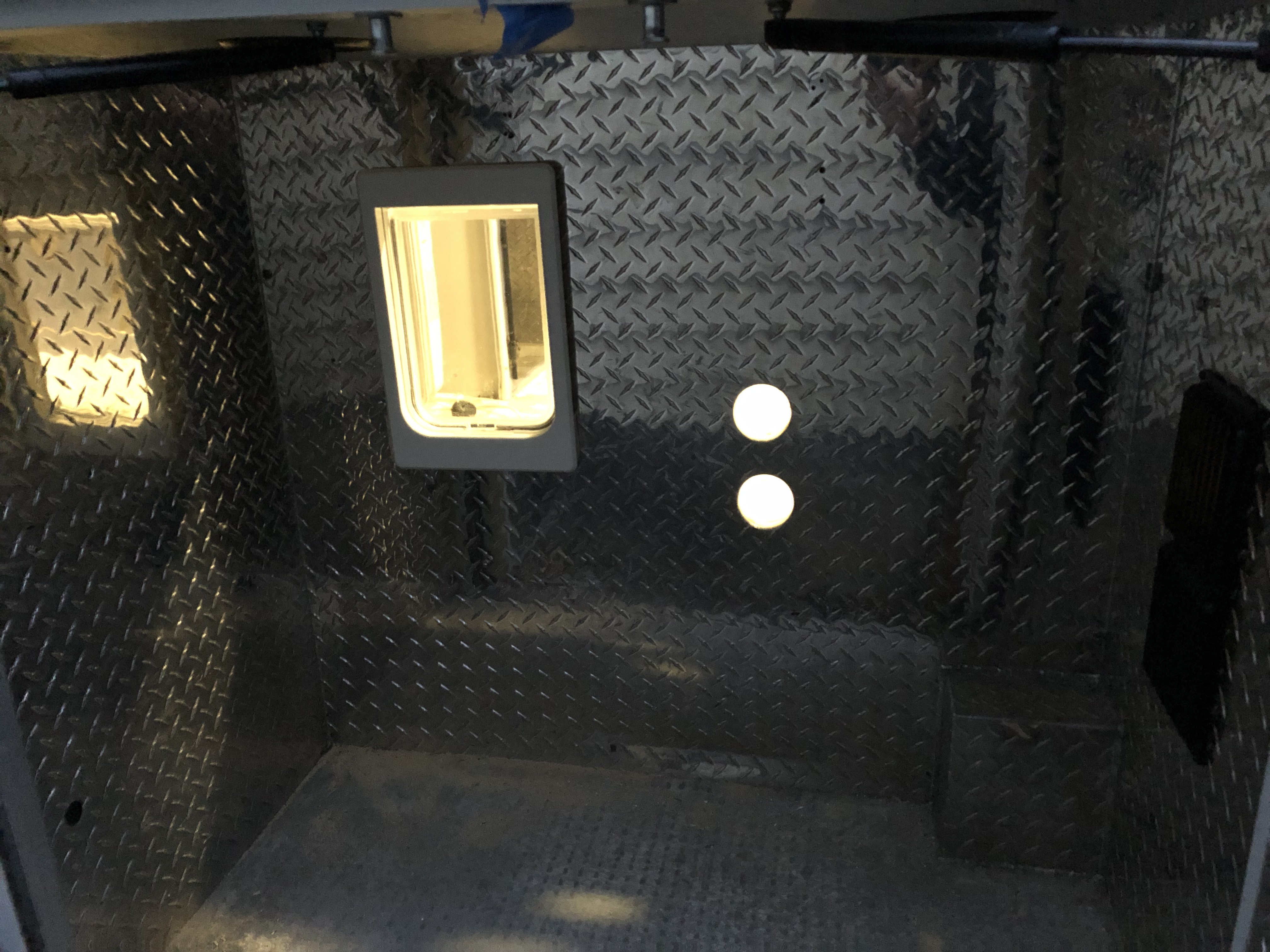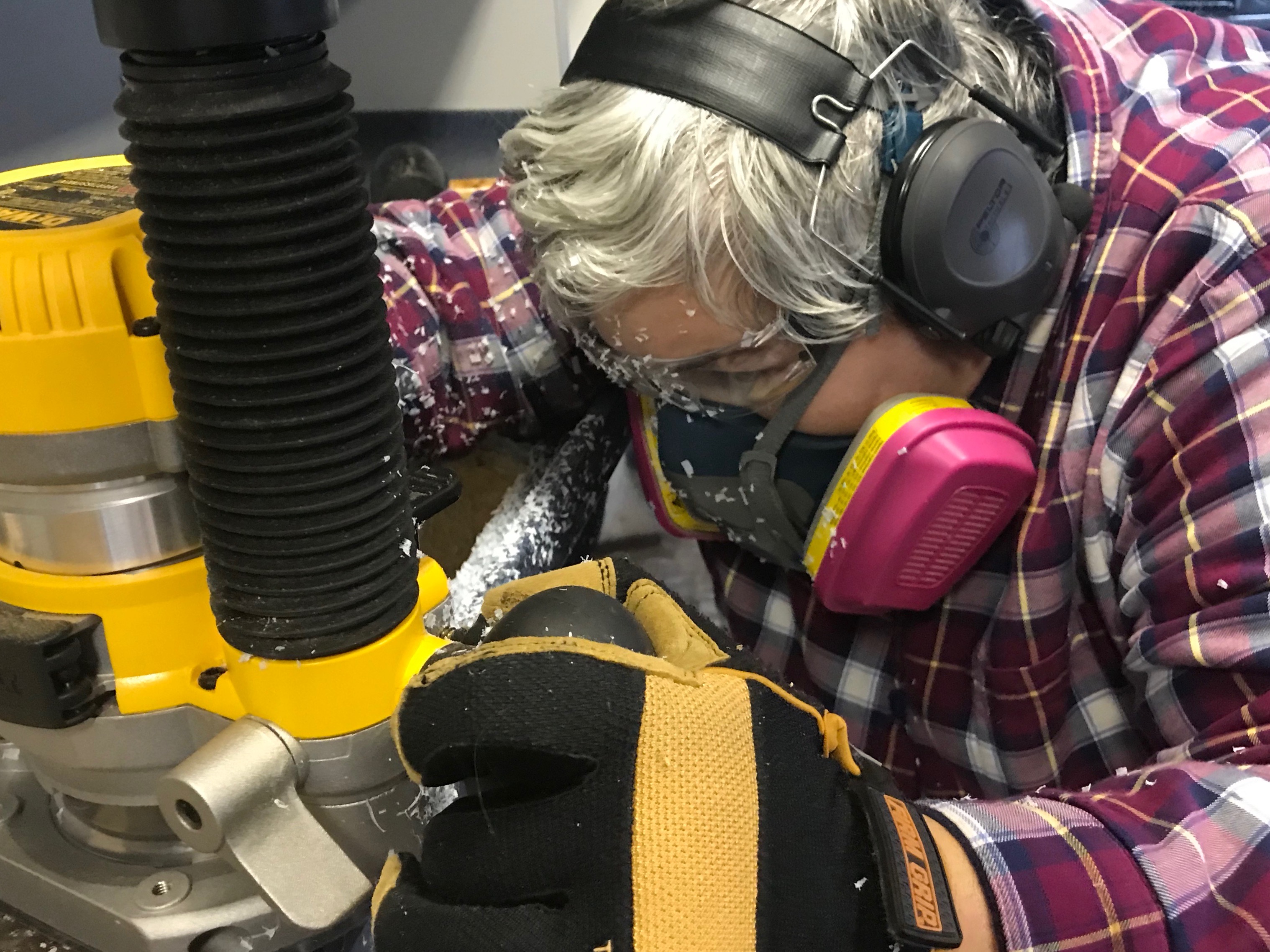
For those keeping track, this is our 4th attempt at adventure vehicle. Many people wonder why, out of all the myriad vehicle choices, we’d choose an ambulance. This post will attempt to explain why an ambulance may be one of the best choices out there for inexpensive overlanding vehicle.
[Dachary adds: inexpensive overloading vehicle for us. Based on our needs and desires. YMMV.]
Requirements
Every overlander has their own, unique requirements. Ours have changed over time. How we ended up with these is a post unto itself, but the short version is that we want to travel with our dogs and we’ve learned a number of lessons from our past travels and vehicles.
- Good insulation. Must be able to stay warm when crossing mountain ranges, or anywhere in Bolivia. Must not cook us to death in the sun. This isn’t really an option with cars.
- Ability to keep dogs cool, or warm while we wander off to explore ruins (or whatever).
- Ability to go from the cockpit to the back without getting out.
- Safety.
- Ability to withstand excessively crappy roads
- Refrigerator
- Cooking
- Emergency Bathroom facilities (porta-potty is fine).
- Good travel range (i.e. can go plenty of miles between fill-ups.)
- Not be a money pit.
- Storage space
- safety gear
- recovery gear
- clothes for all seasons
- Ability to park almost anywhere.
Nice-to-haves
- Living space
- Headroom to stand
- Good Fuel Economy
How ambulances stack up
I’m speaking specifically about Type III ambulances like ours, but most of these qualities apply to all ambulances.
Safety
Most people are unaware of RV construction. Most RVs are made of twigs, glue, and Paper Mache. Maybe not literally, but when you’re in an accident, there’s little difference between that and their actual construction.
The typically relatively small Class A motor home builder will then essentially build a stick-built home on top of [a] truck chassis. Unlike the extensive crash worthiness safety requirements for automobiles, the RV manufacturers may have little or no legal crash worthiness standards which apply to their work. I suspect some manufacturers may not even consider crash worthiness safety. I have seen a number of incidents where even at modest impact speeds, the stick-built home on top of the truck chassis will essentially slide off the chassis. Some manufacturers make a much greater effort to try to attach their stick-built “home” to the chassis than others. Although the modern Class A motor home built on a truck chassis may superficially look very similar to the bus conversion vehicles, there may be no similarity whatsoever in terms of structural integrity. - GrizzlyLaw
Yes, you can get aluminum frame, and even steel frame RVs, but how many of them are side-impact rated? The commercial bus conversions probably are, but that’s way too big, and too expensive, for us.
Type III ambulances are made with tough aluminum boxes attached to the back of a van. Those boxes are crash tested. They won’t peel back like an onion skin. They’ll survive a side-impact, and they won’t crumple if you have a roll-over. Imagine driving your home through the worlds worst driving (India) in something that was built of sticks. Now imagine something that’ll crumple the truck speeding into it. That’s the ambulance box.
If you are traveling with a family, you’ll be happy for all the seat-belted sitting positions in the back. Ours comes with five seat-belted seats in the back, plus your standard 2 up front. One of them is kind-of in the way, and the other is probably terrible to ride in but…
On the downside, they are on commercial vehicle bases, which in the US means you won’t get all the modern computer safety stuff like auto-braking systems, and things to steer you back into your lane. You’ll be responsible for hitting the brakes yourself.
Engine Power
Ours is built on a Ford E–450 “Super Duty” base. It’s got a 6.0L Power Stroke® V8 Turbo Diesel. That’s 325 horsepower and 560 lb-ft of torque. It’s not fast, because it weighs ~11,500 lbs (~5,216 kg), and is roughly as aerodynamic as a brick, but it has no problems pulling itself up steep hills. This is not something we could say of the Vanagon, even with its Frankenstein turbo-diesel engine.
It’s not the best Diesel engine Ford has made, but the problems are well-known at this point, and the better engines are in notably older vehicles at this point.
Electrical Power
Ambulances come pre-wired with 12v and 120v (in the US) electrical outlets, and shore power. Not only that, they were wired by people who know that if they screw up, there’s a decent chance that someone will die.
They come with a pure sine wave inverter, and everything is wired into two alternators. The house batteries are on an easy-to access slide-out tray.
Some ambulances come with built-in generators. Ours did not, but we have space to add one (and run it there) without impacting the living area. We’re pondering this so that we can maintain AC for the dogs without leaving the vehicle running.
We have enough power to run a rice cooker while we drive, or power Dachary’s Burr Grinder for delicious morning coffee.
It should be noted that many new ambulance owners feel completely overwhelmed by the sheer number of wires you find in an ambulance. There_are_ a lot of wires, but they are extremely well labeled. Every wire says what it is, and most manufacturers seem to be happy to help folks out with wiring diagrams for their specific unit, and they are amazing. We’ve got a 50 page document describing every single tiny piece of our electrical system in glorious detail. I think of it like a dictionary. I don’t need to know every word in the language, but it’s good to be able to look new ones up when I need to.
[Dachary adds: I’ve been insisting to Kay that I’m not interested in doing another vehicle build. I don’t want to reinvent the wheel AGAIN. So we seriously looked at/spoke with some folks selling camper vans whose interiors we didn’t hate. But… many DIY van-lifers don’t have a clue about the electrical systems. One guy we spoke with described all the hallmarks of some nefarious electrical gremlin - without even realizing that’s what he was describing! I realized that at the very least, many of these people are probably benignly neglecting their electrical systems… at worst, there could be serious safety concerns/fire hazards with electrical work that prior owners have done on their camper vans.
Ultimately, the idea of inheriting someone’s electrical mess was just too unbearable for me. The ambulance, with its “life-or-death” well-maintained and marked electrical system - that some prior owner hadn’t hacked (badly) - that was just too appealing to me to pass up. That, and the climate control, is what finally sold my skeptical self on the idea of an ambulance as a travel vehicle.]
Solar Power
We don’t have it yet, but we have plenty of roof space for solar panels. Even better, there are some new low-power car AC units that we could, in theory, power with solar.
Good Range
We have a 55 gallon (208L) gas tank. This means we’ve got about 600 miles of range. This is useful when you’re in a land with gas shortages (Argentina), where diesel stations are rare, where gas stations won’t sell to foreigners (Bolivia), or when you’re simply driving a very long dirt road.
[Dachary adds: sadly, the fuel economy doesn’t stack up to… anything else we’ve ever driven. Even the Vanagon on a bad day got ~18MPG, with over 20 average. The seller estimates the ambulance at 11MPG. Ouch. Even the EarthCruiser reportedly gets better than that.]
Good Insulation
Ours spent winters keeping EMT folks warm in winter, and comes with 2 inches of insulation from the start. If we find we need more, it’s a matter of removing the cabinetry. Not easy, also not complicated.
RVs are frequently not well insulated, and not constructed in such a way that you can easily add more.
While we’re unlikely to spend much time in snow-blanketed areas, the reality is that we will be crossing mountains, traveling to high elevation areas, and visiting deserts where things can get get cold at night.
Box access from Cockpit
A number of people say this is important for safety reasons. The belief is that “if something goes wrong” you can jump in the front and drive off immediately. That’s mostly true, but it’s not why we want it.
We’ve learned that minimizing small barriers of resistance can have a huge emotional impact. Our doorway isn’t that big (we can expand it with work), but it’ll make a huge impact on days that are less than pleasant outside.
Our dogs can relax in the back, or come visit us while we drive. Someone can work in the back, seat-belted in, while the other drives. We can talk to each other through the passage, although I’m sure we’ll have to talk loudly.
Handling crappy roads
Many RVs will literally shake themselves apart on crappy roads if you drive enough of them. There’s a good reason overlanders don’t take them. Our welded aluminum box will not suffer from this shortcoming. We may break an axel, or bend a rim, but we can be reasonably sure the box will remain intact.
We do have one notable downside when compared to a typical truck or SUV. Our exit angle is terrible. We can address this in the future, with some creative cutting and welding, but for now, it’s something we’re going to have to be aware of.
Our ground clearance is a very average 7“ (~18cm). It’s not great. it’s not horrible. For comparison, a Toyota 4Runner SUV has 9.6” (~24cm) of clearance.
With this vehicle base, however, we could do a 4WD conversion at some point and gain some better handling of crappy roads. Larger tires should give us more clearance too, but we’ll deal with that later.
[Dachary adds: yes, we “could do” a 4WD conversion. If by “could do” - Kay means we can pay someone roughly $11,000 to do it. So, yeah, possible… but very expensive, and not sure if we’ll ever invest in that.]
Ability to keep dogs cool, or warm
One of the requirements for ambulances is their ability to maintain internal temperature. If you’ve got a patient suffering heat stroke you can’t stick them in a sweltering hot box. If you’ve got someone with hypothermia you can’t stick them in an ice-box. Excessive heat can bring on a number of medical complications with certain conditions.
Ours is made by a company called PL Custom. One of their differentiating factors is their climate control. Since 1990, they’ve been shipping boxes with 60,000 BTU of heat and 38,000 BTU of cooling. For some perspective, a typical window air conditioner is about 5,000 BTU and they are for larger rooms than ours. We only have a teeny tiny box to heat or cool.
On top of that, the exhaust / ventilation system is so good we can literally replace all the air in the box in 90 seconds. Unfortunately, these systems only run when the engine is on because it can suck down a lot of power.
We’re considering a generator so that we can run the AC during the day as we leave the dogs to go explore places that don’t allow them. For night-time heat (without the engine running), we’ve decided to install the newer model of the Propex propane heater we had in the Vanagon. Our past experience with the Propex tells us this will use very little fuel to heat such a small space, and even less so with good insulation.
Dogs and Cats can’t sweat, so temperature maintenance is extra important.
Refrigerator
Ambulances don’t come with refrigerators, but they come with plenty of space to put one in, and they’re pre-wired with power everywhere.
We found having a fridge to be an absolute game-changer. We’ve currently got an amazing Pelican cooler that we bring in the Outback, but it’s just not the same. Being able to go back and grab a cold drink, have yogurt at breakfast, or keep milk cool for your coffee? I can not begin to describe how much that changes living on the road.
We have an additional reason though. We cook for the dogs. Ben is an old dog, who ended up refusing to eat any normal dog food for more than a couple meals. We tried quality brands, we tried not-so-quality brands. Eventually, we started cooking for him and his quality of life improved dramatically. He started running, and playing, again. He was happier. Our veterinarians have all been amazed at how good his blood-work is. We cook two meals at a time for the dogs and they last about 4 days. But that’s a lot of volume that needs cooling.
Cooking
We need to cook for the dogs, but this would be an important thing even without them. On the road in the US you tend to end up eating at a lot of chain restaurants, and consuming way too much fast food.
Internationally, I’m a strong advocate for always eating street food, but there were times in Mexico where our breakfast, lunch, and dinner options were “carne asada”. There is only so much carne asada a person can take. In Patagonia, our food options were frequently gas-station sandwiches (just as bad down there as in the US), and more gas station sandwiches.
Sometimes foreign foods (or water) leave you feeling unpleasant at best, and you just want something safe, and simple for your tummy, like rice and chicken.
Having the space, and capabilities, to cook your own food dramatically changes the trip. Being able to cook your own meals can also help save money, and extend your trip.
We’re putting in a small 3-burner range with oven. We’re contemplating a microwave. We don’t like microwaves, and if it was just us we wouldn’t install one in a million years, but the prospect of heating up the dogs’ food twice a day without one is not enticing. Dogs aren’t generally huge fans of refrigerated food. Maybe we can convince them otherwise.
[Dachary adds: I’m skeptical of whether we can convince them to eat cold (refrigerated) food. Dogs are olfactory creatures. Cold food doesn’t smell like much to them. When we heat it up, though, presto - a feast for all the senses! At least, I think that’s why my old dog eats the home-made food we cook for them.]
Emergency Bathroom Facilities
A number of “van life” people just use bathrooms at restaurants, gas stations, or gyms they have memberships to. The people who have made this decision obviously do not travel internationally. When you travel internationally, you encounter foods that disagree with you. They frequently disagree with you when you’re on the road, far from a gas station, but without the ability to quickly get away from roads with traffic.
We can pull off on the side, or any exit, and “explode”, without dropping our pants on the side of the road while cars go by. (Yes, we’ve done that…multiple times). Being able to refresh all the cabin air in 90 seconds will help here too. ;) Also, sometimes you find yourself peeing every 10 minutes for no apparent reason. This isn’t a problem. You don’t need to do “the pee-pee dance” in your seat and hope for another exit. If you have diarrhea that just won’t stop, you can just hang out in back while the driver cruises on down. Not necessarily legal but…
[Dachary adds: let’s not mince words here. Even in the US, this can be a problem. I’m not a picky eater, but my body doesn’t always do great at processing what I eat. I keep Imodium on me at all times when traveling. On our last trip, though, it wasn’t the food that gave me problems, but the antibiotics I was taking for a wisdom tooth infection I developed while on the road. I literally had to drop trou and have an emergency evacuation by the side of the road - and yes, a car drove by while my butt was hanging out. I’d like to avoid doing that again, if I can help it.]
Most of the time, we just use it for peeing in the middle of the night, and save the solids for our next gas station stop. We both hate the idea of some sort of pee tube that goes goes out under the van for so many reasons. Porta-potties are trivially easy to dump out in a toilet, and you can go quite a long time between dumps if you use it like we do.
Storage Space
Ok, we don’t need much storage space compared to most travelers. We’re actually pretty good about bringing very little stuff, but we also like to bring a serious first aid kit, actual recovery gear (because there is no AAA where we go), spare parts, tools to install the spare parts, enough food and water to get to past the mountains / across the desert, clothes for the cold (on the mountain), clothes for the hot (in the desert), and so on. On top of that, I think we’ll need to be able to work from the vehicle. All together, it’s a goodly amount of “stuff”.
[Dachary adds: don’t forget about the pets! They have “stuff” too. Dog beds, coats for cold weather, doggy first aid, bowls, etc. And kibble for the cat. Pets definitely add to the logistics.]
Ambulances are rife with with storage spaces. You think we’ll be bringing a lot of “stuff”. It’s nothing compared with amount of “stuff” an EMT crew carries.
Not a money pit
Type I, Type III, and Mini mod ambulances have a secret feature that not many people are aware of. You see, the box is more expensive than the vehicle it’s mounted on. If you’re an ambulance company, and the vehicle wears out (rusts from winter salt or whatever) you really don’t want to have to re-buy a new box to go with the replacement. It’s standard practice to take the box off of an old ambulance and move it to a new one.
So, even if we’ve chosen wrong and the van part of our built dies on us, we can just pop the box off and stick it on a new van base. Yes, we’d need to buy a new vehicle to stick it on, but that would be the case regardless of if it was an ambulance or not. If we use it enough, we can expect that the vehicle will eventually give out, but the time and money we’ve spent upgrading and personalizing the box will not be lost.
If we decide we need something more off-road capable, we can have a 4WD conversion done on the van. If we decide we need some monster military truck, we can take it off and stick it on that. Unlike Sprinters, RVs, and almost everything else out there, our home is not tied to the vehicle.
Bonuses
Our walls are all straight. Van construction is frequently hampered by the slightly curved walls and ceiling. It’s not a huge deal, but it’s nice to not have to deal with that.
Oxygen. Ever had severe altitude sickness? Dachary got it pretty bad when we went to Bolivia. Maybe she would have done better if we took the time to acclimatize. Maybe not. There are only 2 solutions. Getting to a lower elevation, and breathing more oxygen. We fully intended to utilize the oxygen tank holder and the oxygen ports in the vehicle. Also, it can really help certain types of headaches.
Why Not RV?
Construction quality, size, cost, layout.
As previously mentioned, construction quality is a huge factor. Most RV construction would rip itself apart on our travels. The ones that wouldn’t are things like the huge metal busses, which can’t go on the roads we want to travel and are crazy expensive.
[Dachary adds: to be fair, the ambulance is damn heavy. It may not be as wide or as long as the huge metal bus things, but it will be limited in roads it can travel, too, compared to our motorcycles. On the upside, we encountered plenty of heavy trucks in our Latin American travels, so the roads we intend to travel can probably take the ambulance just fine.]
RVs tend to either be van-sized, or enormous. The enormous ones can’t go down twisty bumpy dirt roads. The van-sized ones have terrible ground clearance and terrible layouts. You can get the van-sized ones used for non-crazy prices, but the ones that aren’t crazy expensive are generally pretty old, and they still have crap ground clearance and layouts.
Cost. Good RVs are not cheap. One of the only RVs that would actually match our needs (the EarthCruiser) is $250k new, and essentially no bank wants to finance it. We don’t have $250k. If we did, we’d totally call them up instead of buying an ambulance.
Layout. The floorpan is a huge deal when you’re living in your vehicle. Most RV vans have a terrible layout. It’s hard to verbalize just how bad most van and larger RV layouts are for living in. They may be fine for a weekend or a week, but living in them would be terrible. Way too cramped. Additionally, the vertical walls that they build around the bathroom make it seem _much_smaller. You’re living in under 100 square feet. You’re going to hear, and smell, everything. Get over it.
We don’t want a trailer RV. We’ve considered the Scamp after speaking with a couple who were traveling in theirs. The fiberglass construction of those might actually hold up to rough roads, but they’re really designed for traveling on smooth American roads. Also, we’d end up spending most of our days sitting in our car, and we’d need to buy another vehicle to pull it since Dachary will be staying behind for a while.
Why Not Sprinter Van
Cost and Space. If you could buy 4WD sprinters used, or if new ones weren’t $60k, I’d have seriously considered it. Used 2WD Sprinters cost about as much as a used ambulance, or more (usually more). Type III ambulances have way more living space. It’s not even a question. They also come with a ton of high-quality storage. We’ve got interior, exterior, and some accessible from inside and out. Most ambulances come with more interior storage than ours, but for whatever reason ours has additional exterior storage. We’ve also got a fair amount of dead space in our cabinetry which we’ll be using for things like water tanks, and drawers.
A Sprinter gives you roughly 60 square feet of living space. Our ambulance gives us 90 square feet. Keep in mind, ours comes pre-insulated, pre-wired, with well made cabinetry, and seat belts.
We’ve got 2 dogs and a cat. We need space for us, for them, and for a litter box. We could make it work in a Sprinter, but an ambulance is better.
Why Not a Truck Camper
Construction, layout, space, trapped in a truck.
A truck camper does logically solve a lot of the problems. It’s easy to get a 4WD truck that can handle shit roads. Truck campers have many of the comforts of home. On the downside, though, they’re totally separated from you (no pass-through) and you have to spend most of your days trapped in a truck cab. You’d have to shell out more money for the big cab. It would be miserable for the dogs, and there’d be nowhere for the cat (or the litter box).
Also, most truck campers use standard RV construction, which is crap. All of them have space issues. The ones that are actually worth considering for us cost as much as a new truck, and still leave us trapped in the cab. None of them have space to move around. They have space to stand and cook, space to sit, space to sleep. Being trapped in there on rainy days would suck.
We would also need to buy a powerful truck to haul it up steep mountain passes.
Bottom line:
There are lots of vehicle options in the world. We’ve traveled on motorcycles. We brought the dogs along on the Ural. We attempted to travel in the Vanagon, with mixed success; it taught us that we loved the camper amenities, but couldn’t seem to get away from mechanical issues.
We love the Outback, and it’s fine for road trips in the US, but doesn’t suit our desire for a portable home. After the last cross-country trip, where we woke at 3am with bed bugs and went to Defcon 1 to evacuate the hotel and leave the little buggers behind, we’re not so interested in a repeat.
We want our own little space to sleep, do simple cooking, use toilet facilities in a pinch, and bring along our critters. With all the amenities the ambulance offers - and at a price point we can actually afford - it’s the next logical base for our newest experiment. Hopefully this one sticks!





